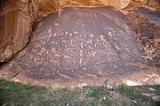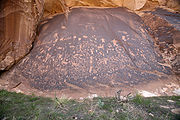
Newspaper Rock State Historic Monument
Encyclopedia

Utah
Utah is a state in the Western United States. It was the 45th state to join the Union, on January 4, 1896. Approximately 80% of Utah's 2,763,885 people live along the Wasatch Front, centering on Salt Lake City. This leaves vast expanses of the state nearly uninhabited, making the population the...
, western United States
United States
The United States of America is a federal constitutional republic comprising fifty states and a federal district...
, located to the east of Canyonlands National Park on Hwy 211. It is 28 miles northwest of Monticello and 53 miles south of Moab. The Monument features a flat rock with one of the largest known collections of petroglyph
Petroglyph
Petroglyphs are pictogram and logogram images created by removing part of a rock surface by incising, picking, carving, and abrading. Outside North America, scholars often use terms such as "carving", "engraving", or other descriptions of the technique to refer to such images...
s.
Formerly a state park, Newspaper Rock is now designated a State Historical Monument, and is situated along the relatively well-traveled access road into the Needles district of Canyonlands National Park
Canyonlands National Park
Canyonlands National Park is a U.S. National Park located in southeastern Utah near the town of Moab and preserves a colorful landscape eroded into countless canyons, mesas and buttes by the Colorado River, the Green River, and their respective tributaries. The park is divided into four districts:...
, 12 miles (19.3 km) from US 191 and 30 miles (48.3 km) from the park boundary. The 200 square feet (18.6 m²) rock is a part of the vertical Wingate sandstone cliffs that enclose the upper end of Indian Creek Canyon, and is covered by hundreds of ancient Indian petroglyph
Petroglyph
Petroglyphs are pictogram and logogram images created by removing part of a rock surface by incising, picking, carving, and abrading. Outside North America, scholars often use terms such as "carving", "engraving", or other descriptions of the technique to refer to such images...
s (rock carvings)—one of the largest, best preserved and easily accessed groups in the Southwest. The petroglyphs have a mixture of human, animal, material and abstract forms, and to date no-one has been able to fully interpret their meaning.
Petroglyphs
The first carvings at the Newspaper Rock site were made around 2,000 years ago, left by people from the Archaic, Anasazi, Fremont,Navajo, Anglo, and Pueblo cultures. These petroglyphs, pecked into these rocks allow a glimpse of the life and world of the people who farmed the Puerco River Valley 650 to 2,000 years ago.In Navajo, the rock is called "Tse' Hane'" which translates to a rock that tells a story.
The petroglyphs were carved by Native Americans during both the prehistoric and historic periods. There are over 650 rock art designs. The drawings on the rock are of different animals, human figures, and symbols. These carvings include pictures of deer, buffalo, and pronghorn antelope. Some glyphs depict riders on horse
Horse
The horse is one of two extant subspecies of Equus ferus, or the wild horse. It is a single-hooved mammal belonging to the taxonomic family Equidae. The horse has evolved over the past 45 to 55 million years from a small multi-toed creature into the large, single-toed animal of today...
s, while other images depict past events like in newspaper. While precisely dating the rock carvings has been difficult, repatination of surface minerals reveals their relative ages. The reason for the large concentration of the petroglyphs is unclear, making the rock somewhat of a mystery.
The dark coating on the rock is called desert varnish and presented an opportunity for creativity. The ancient artists produced the many types of figures and patterns by carefully pecking the coated rock surfaces with sharpened tools to remove the desert varnish and expose the lighter rock beneath.
The location is near a stream and trail in an area with long expanses of otherwise impassable vertical cliffs. The carved face is located along State Route 211
Utah State Route 211
State Route 211 is a state route in Utah that is an access road for Newspaper Rock State Historic Monument and the Needles district of Canyonlands National Park. The entire length of the highway has been designated the Indian Creek Corridor Scenic Byway....
, the access road to Canyonlands National Park
Canyonlands National Park
Canyonlands National Park is a U.S. National Park located in southeastern Utah near the town of Moab and preserves a colorful landscape eroded into countless canyons, mesas and buttes by the Colorado River, the Green River, and their respective tributaries. The park is divided into four districts:...
Needles District.
Visiting
The monument has free entry, though no facilities apart from a carpark, sometimes with Indian jewelry sellers in attendance. The setting is peaceful and sheltered, as the canyon at this point is quite narrow, overgrown by bushes and tall cottonwood trees, with the clear waters of the creek flowing close to the road, and sheer reddish cliffs rising 250 feet (76.2 m) above. A picnic area is located on the far side of the road, next to what was once a campsite though this was closed in late 2006 because of increased awareness of the dangers of flash floods. Other places on the cliffs to the south have smaller groups of petroglyphs, though the main attraction for most people along upper Indian Creek Canyon is rock climbing, since the Wingate cliffs here provide many advanced, technical routes, easily accessed from the road.Age of site History: The pictures at Newspaper Rock have been inscribed into desert varnish
Desert varnish
Desert varnish, or rock varnish is a orange-yellow to black coating found on exposed rock surfaces in arid environments. Desert varnish is usually around one micron thick and present nanometre-scale layering...
, a blackish manganese-iron deposit that gradually forms on exposed sandstone cliff faces owing to the action of rainfall and bacteria. The older figures are themselves becoming darker in color as new varnish slowly develops.

